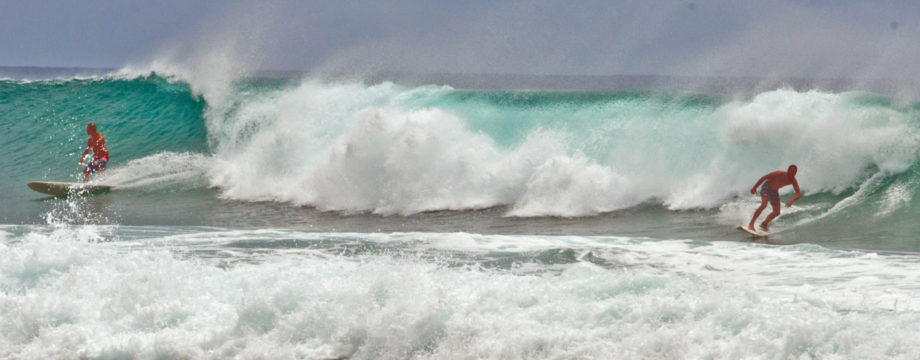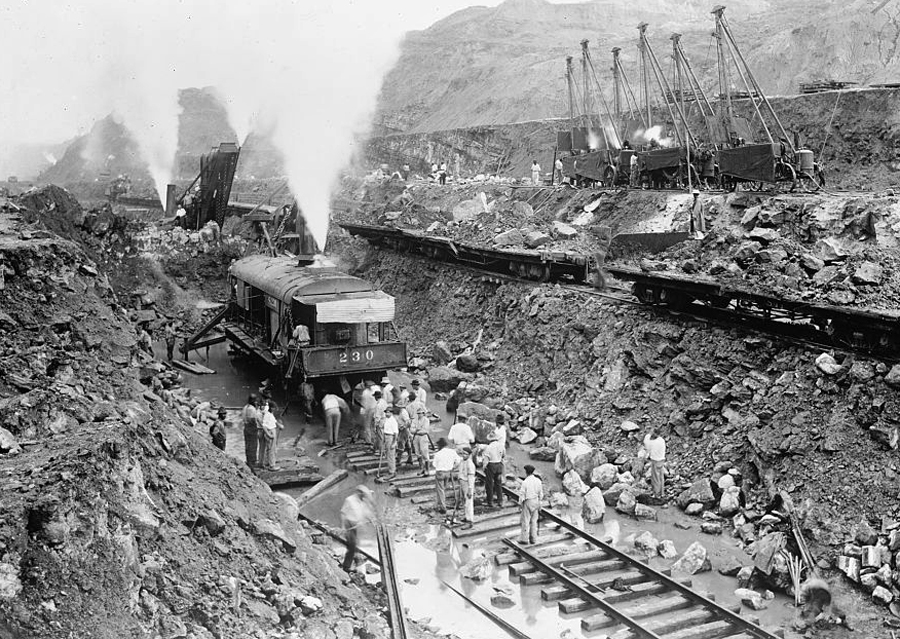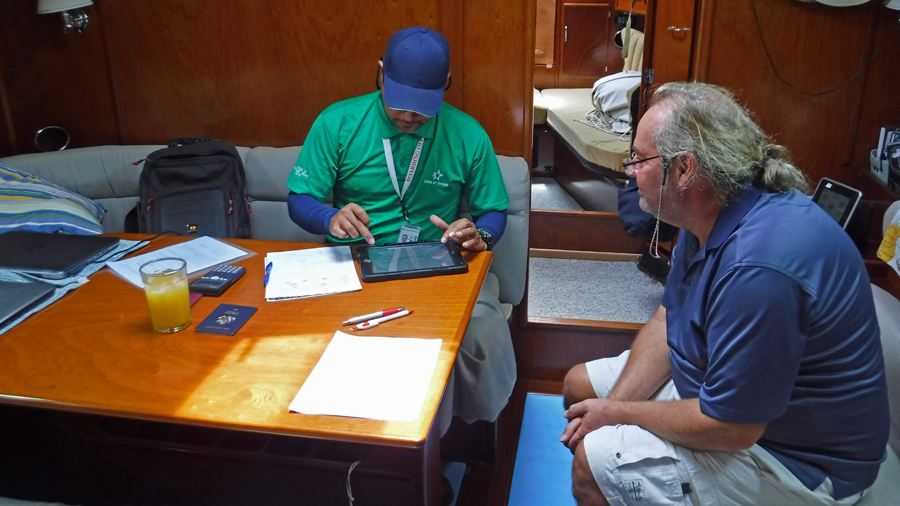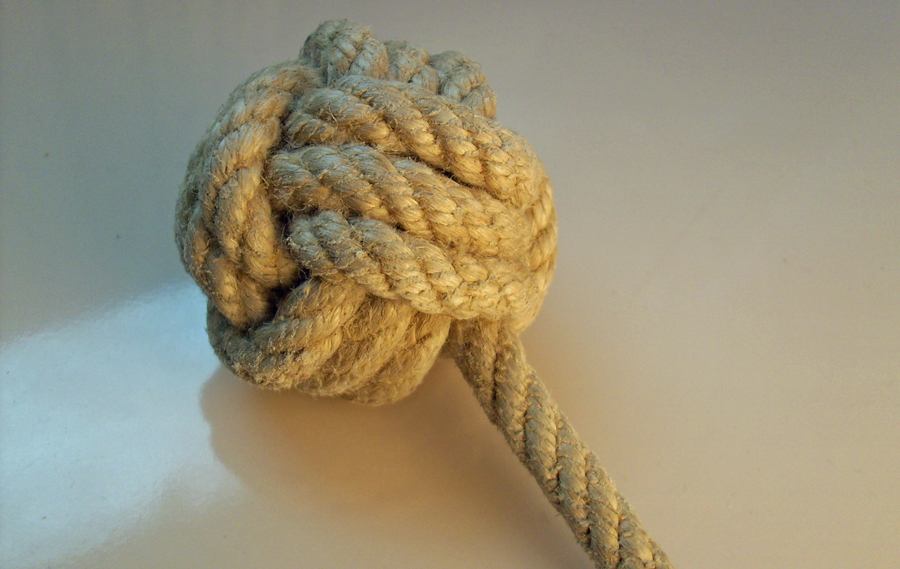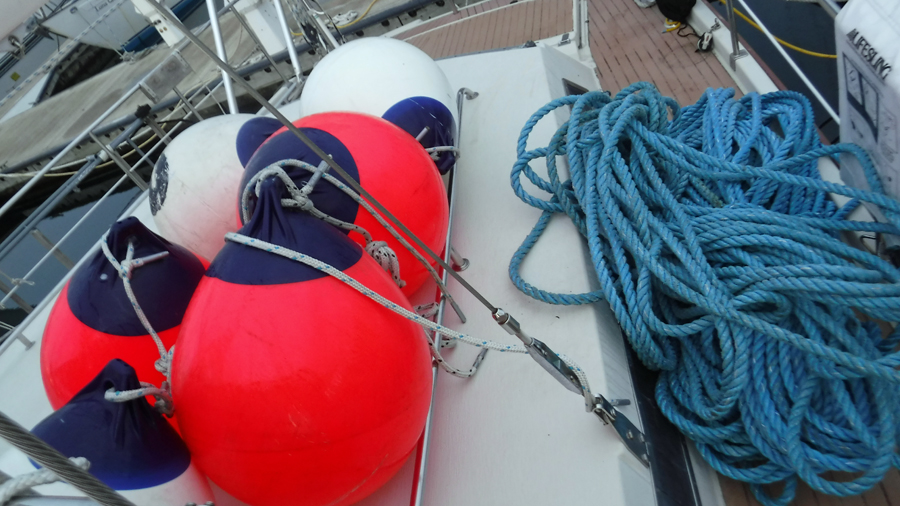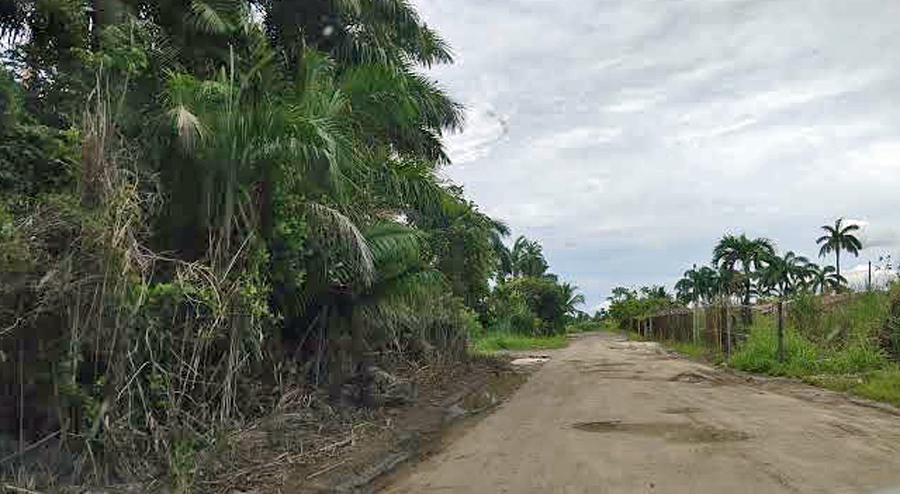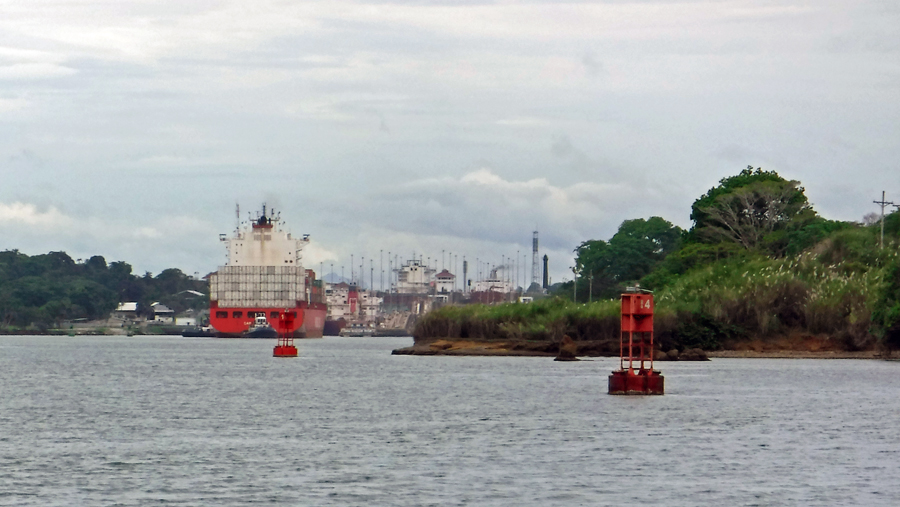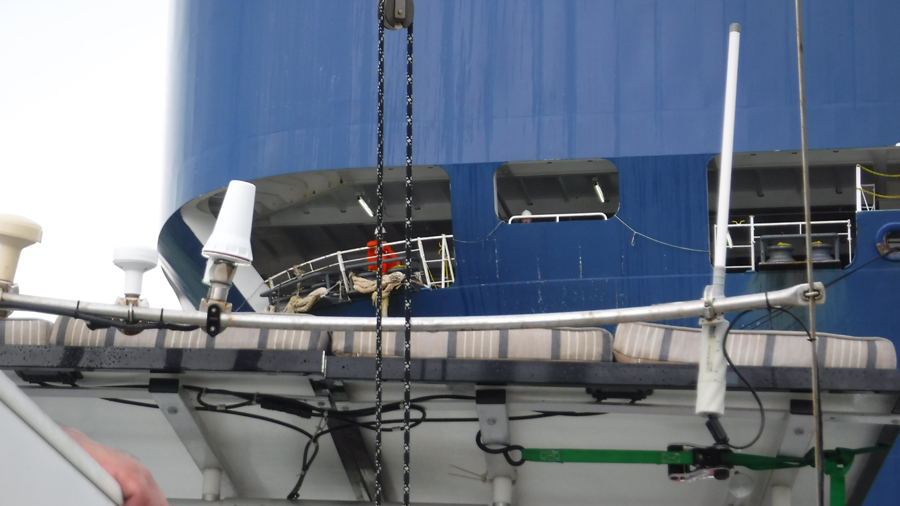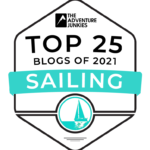Absolutely feakin’ awesome! Wow! We went through the Panama Canal! I won’t say this was a dream of a lifetime come true but it’s pretty darn close. Because there is so much to talk about, I am going to have to divide this post into two parts. I’ll begin with the preparation and take you to the morning of departure. I’ll post part two in a couple of days, it’ll cover the one day crossing from the Caribbean to the Pacific. Kick back and get a drink. These are very long posts.
Once again, doing our own research paid off with dividends. We found many cruisers have bad or outdated information and are more than willing to share. In Shelter Bay Marina (the entry point on the Caribbean side), the docks are full of people waiting to transit. The marina chatter quickly turns to passage requirements and these are conversations we try to avoid. People offered us advice based on things they had heard and understood to be factual. It is amazing the amount of bad information communicated by these sailors trying to be helpful.
Our first decision regarding a transit was to do it with or without an agent representing us. It is entirely possible to transit the canal doing all the paperwork yourself and taking the time to try and figure out the regulations. This method also requires posting a cash bond with the canal authorities. The bond for all boats regardless of size is currently US$891.00 plus bank fees. This is forfeited if damage is done to the canal by the transit vessel or if the vessel fails to comply with canal regulations such as discharging oil, not departing on time, not maintaining speed, failing to have line-handlers or not providing bottled water for the advisers (more on this later). Else, the bond is returned a couple weeks after the transit. The fee to hire an agent guiding us though the entire process is US$350. With an agent, there is no need for the bond. This is the option we chose. In my opinion, in addition to having an expert consulting with us, this was in fact the least expensive option. We reviewed several websites and cruising resources and settled on Erick Galvez. Erick was also the agent for a neighboring boat on our dock and came highly recommended due to his excellent communication and follow up. Erick was top of the list in almost all cases where we sought information regarding canal agents. It turns out his reputation is well deserved.
Cindy does almost all of the administrative stuff for Cream Puff. Her attention to detail is much better than mine when it comes to paperwork. She decided upon which agent and was the main point of contact for him. Whenever we had questions, she could text him and he responded quickly with answers.
Had we have chosen to post the bond, this would have required us to file our own paperwork and take a trip to Colón to deposit cash into the Panama Canal Authority’s bank account for the bond. Due to limits on ATM withdrawals, it also meant having to go to more than one ATM to obtain the cash. Walking about Colón with tons of cash is a very bad idea and extremely stupid thing to do. The city is known for crimes against tourists and is darn right dangerous. Every publication we have read on Panama and the Panama Canal including our marinas web page warns of high crime in Colón. Even the locals warn to be extra vigilant there. Yet, some cruisers and tourists totally ignore the warning as if they are unwilling to accept how dangerous a place can really be. And, just because nothing happens to them on one particular day they announce to the community a known to be dangerous place is really safe.
Should someone survive the walk about Colón, the funds are verified and the paperwork is submitted. The verification can take a few days. Then the canal authority dispatches an inspector to measure the boat. To use the old cliché, time is money, every day our boat sits in Shelter Bay Marina it costs us about US$48.00 for dockage. The DIY process is much slower than using an agent. Assuming all the paperwork is done correctly and additional documentation is not required, it can take 2-6 weeks to get a transit date.
One of the first things Erick told us, if we have questions we need to ask him. He warned us against taking advice from other cruisers, places like Facebook or blogs of other cruisers. I immediately liked this guy. Communication is key and Erick knew this to be a top requirement for first timers. We have lots of questions. Information and regulations change and what may have been true yesterday may not be the case today. Erick’s full-time job is to stay abreast of the ever evolving rules and keep us informed. He is also a certified canal agent meaning he has an established professional relationship and is recognized by the Canal Transit Authority (ACP).
Once we returned from our trip to Panama City on Friday, we knew we wanted to be on the Pacific side. We didn’t expect things to happen so quickly! Based on what our research and what boaters were talking about on the docks, it appeared as though the time from filing the paperwork until the transit date took at least two to six weeks. This was not the case. Remember what Erick said about listening to other cruisers? On Saturday, Cindy contacted Erick and filled out his forms. On Sunday, the ACP inspector arrived to measure and inspect Cream Puff. We were also joined on Sunday by Erick’s son James. James collected all the transit fees and billed our credit card. No going to Colon to collect a lot of cash. By Sunday night, we were assigned our SIN number (ship identification number used to identify the vessel by ACP). On Monday, we were given our transit time and date. In a conversation with Erick, he told us we could transit as soon as Wednesday, we asked him if we could push out to Friday as we didn’t expect things to happen so quickly and needed a couple of days to prepare. Later on Monday he confirmed our transit time for Friday. Our entire process from initial contact to transit took less than a week.
I say the agent is the least expensive option when comparing to the do-it-yourself option because of the marina fees. If a boat is sitting on anchor awaiting the time slot then this does not apply. A couple down the dock from us opted for the DIY option. They submitted their paperwork and paid the bond and were awaiting their assigned transit date from the ACP. We started our paperwork about a week and a half after them and already had our date. Ten days of marina fees is about US$470 (plus electricity), meaning we saved $120.00 by using the agent who could expedite paperwork. When we departed the marina, they still had not received their date and were continuing to accrue dockage fees.
Another option boat owners transiting the canal face is whether to hire professional line handlers or use existing crew, volunteers or friends. There seems to be no shortage of sailors sitting in the marina willing to “practice” on someone else’s boat before taking their own vessel through the canal. A couple of weeks ago a person volunteering as a line handler was seriously hurt when his ankle became entangled in the rope as the vessel began to lower in the lock and the line needed to be let out. One of our line handlers was hit on the head with the monkey fist. The monkey fist is a knotted ball at the end of a leader rope used to weight the end enabling the line thrower on the top of the lock to throw the leader line to the vessel. A heaver rope is attached to the leader by the vessel’s line handler and pulled back to the edge of the lock and secured on a bollard. When hit with the monkey fist, count on a big bruise. Personally, knowing what I know now, I would never attempt to transit the canal without professional line handlers.
Four professional line handlers cost us US$400, one hundred per handler. This rate is based on the passage. If the passage takes two days or one day, the rate is the same. Included in our $400 line-handlers fee is the cost of their return back to the other side of the canal. Owners opting to hire their own handlers need to pay for the taxi back. This is about $100. For us, this was included by the agent. We paid for our handlers in advance with our credit card via our agent, Erick. Again, eliminating any need to carry large amounts of cash or visit ATMs in Colón. Many sailors try to skimp here and save some money. Our insurance deductible increased for our boat’s coverage through the canal. Meaning, they expected us to sustain some minor damage and they didn’t want to pay for a claim. It is very easy to bump off the walls of the lock due to the turbulent waters inside. Notice also, we hired four line handlers. Some boats will only hire three and use their spouse as the forth handler. I wanted to ensure Cindy had time to take pictures and document our once in a lifetime trip through the canal and share the helm if needed. She took some great pictures. The literature we read has plenty of stories about non-professional line-handlers taking pictures and not paying attention to the job at hand. The job of the line handler is to keep vessel in the center of the lock. I did not want another sailor practicing line-handling skills on our boat. I also did not want the responsibility of someone being hurt. There are certain times in life where it pays to hire professionals. This is one of those times. $400 is a pittance to pay to ensure the safety of our vessel home. And, it’s much less than hull or rigging a repair.
While the ACP inspector is aboard he verifies we have ropes, line-handlers and provisions for the adviser. An adviser works for the Panama Canal Authority and comes aboard to provide instructions to the captain throughout the canal transit. It is required to have enough bottled water for the adviser for the passage. They will not accept water from the vessels water tank. Based on the condition we have noted with other boats lined up for the passage, I can’t say I blame them for not wanting to drink their water. It is also required to provide hot meals. This is usually lunch or dinner depending on the transit time. This may seem a little picky to those who haven’t done this. Keep in mind; it is hot and humid here. The adviser’s job is to be in the cockpit area (hopefully covered with a bimini for some shade). The adviser arrives at our vessel by boat and has to transfer from one vessel to the other. To expect him to lug an ice chest in addition to his gear in not realistic. Since our ACP inspector arrived the day after we contacted Erick, we did not have ropes, fenders or water etc. Since we had an agent, the inspector knew all this was forthcoming and made the appropriate notes on the paperwork green-lighting us for the transit.
English is the official language of the Panama Canal. All officials speak fluent English. Our ACP inspector did all the paperwork in English. I thought what an interesting job he has going from ship to ship meeting people from all over the world. He jokingly told us a couple of funny stories from his experiences. Apparently, very few Chinese ship’s crew speak English. But, the Chinese will nod like they understand everything he is saying even though they don’t understand a word. Indian people will shake they head sideways while saying they understand. The French don’t like to speak English. He told us our adviser would communicate in English and all radio conversations will be in English. Phew!
During our time with the ACP inspector, we expressed our preferred position in the locks. There are several choices and some positions are more likely to inflect damage on the boat than others. Our top preference was to go though solo. This almost never happens. Small boats are usually rafted together to form three hulls. The center boat does the steering for the raft. All boats are required to have line-handlers but the crews on the outer boats do most of the work while in the lock. Our second choice was to be the center vessel of the raft. This is usually reserved for the largest of the three boats. At 53 feet (58 feet with our dinghy and solar panel overhang) we’d have a pretty good chance at being the larger vessel. This position is called the nest. The adviser on the nest boat is in charge of all three advisers. I looked at this option as having two huge buffers between Cream Puff and the concrete lock walls. I was okay with this. We declined being the outer boat and declined what is referred to as a wall tie.
One of the things we pride ourselves on; if a person spends a day on Cream Puff, they are going to have ample to eat and drink. They can count on living large for a few hours. We both love to cook and in our prior land-life had wonderful dinner parties at our house on a regular basis. This has carried over to life aboard Cream Puff. Cindy made a grocery list and off to the store we went to provision for the transit. We would always rather have too much than not enough. We were expecting a two day passage. This was what was communicated to us on Monday when we received our time. Traveling from North to South (Caribbean to Pacific) is normally done over two days. This means mooring the boat overnight in Gatun Lake. The line handlers stay aboard overnight but the adviser leaves and a new one arrives the next day.
Shelter Bay Marina offers a free shuttle to the grocery store. It takes about an hour to get there, it isn’t very far but requires crossing the Panama Canal either by driving over one of the locks or on one of the ferries. Both methods have to yield to ship traffic which sometimes can significantly delay the trip. While on the bus, we overheard two cruisers talking about their upcoming transit. Their conversation revolved around how much bottled water they planned to purchase at the store for the advisers. One lady said she thought one bottle per day would be ample. Cindy and I both looked at each other in disbelief. Don’t these ladies realize how hot it is here? We spent $150 at the store making sure our crew and advisers would have everything they needed. Beside the 2 cases of bottled water and meals, we included snacks, candy, tons fruit and sodas. We also had beer for the line handlers for evening in the lake.
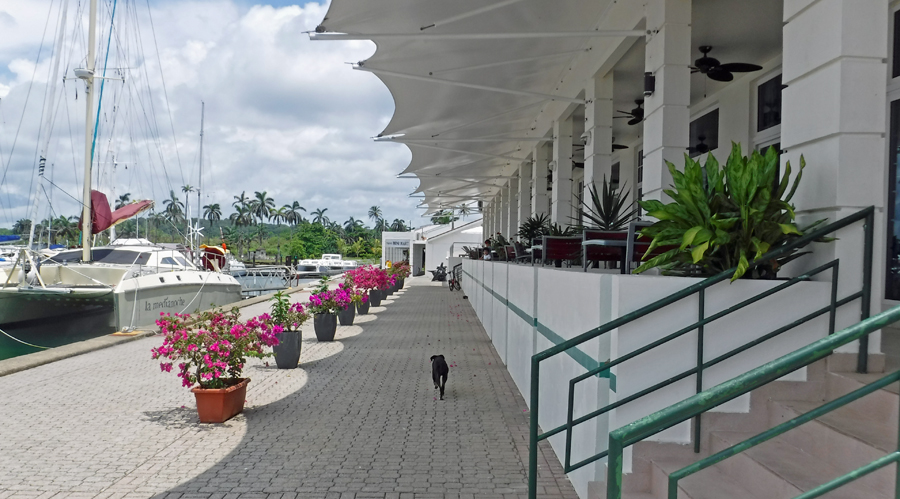
I wonder if the staff at the marina realize all of the pot plants outside of the restaurant line up exactly with the shadow of the roof
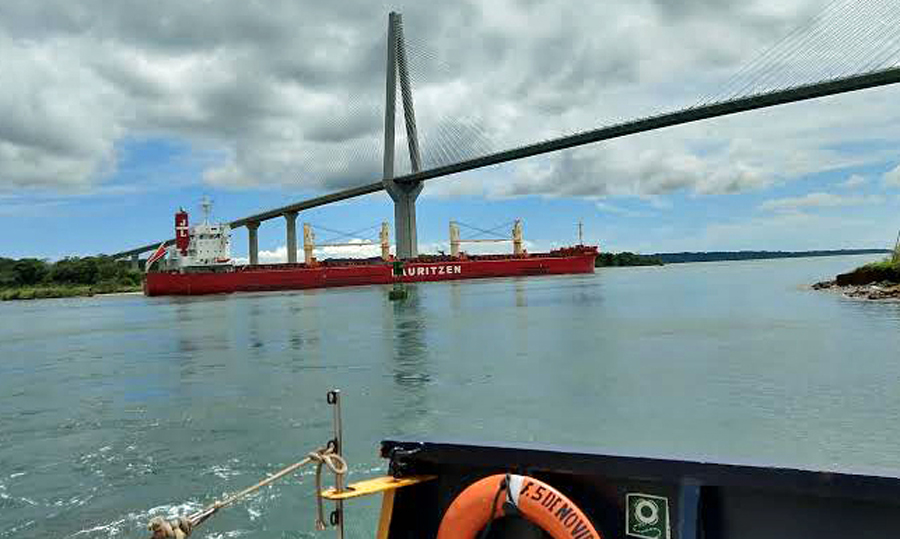
From the ferry crossing the canal we get a great view of the new bridge (opening soon) making the trip to Colón much shorter
Listening to the ladies on the bus complaining about having to spend money on bottled water reiterated a concern I had with being rafted with other boats. Some cheap cruisers will try to save a few dollars by renting old tires (covered with tee-shirts or plastic) rather than proper fenders demonstrating an utter disrespect toward the owners of the boat to which they may be rafted for the lock transits. We do not like to be at the mercy of others. If we were the center boat, our safety is now dependent on their line-handlers. The line-handlers on the outer boats are to keep the raft of boats in the center of the lock. If they have no experience and are friends or other sailors looking for a free trip though the canal the chances of them being proactive verses reactive in the locks is very slim. The comforting thought was they would hit the lock walls first. But, it makes me very uneasy having to rely on other people’s judgment and willingness to part with a few dollars. Hearing these ladies grumble about having to spend a few dollars on bottled water made me wonder about the condition of their vessel’s engines. As I listened, I hoped they would not be tied to us.
Erick called us mid day Thursday. He explained there was an opening in the schedule and inquired about how ready we were. We told him we could be ready by the end of the day. The ACP had contacted him to see if he could fill an open slot on the schedule. He immediately thought of us. He explained we would leave early on Friday morning and transit the canal on one day instead of the customary two. He said he could have our line handlers on the boat Thursday night for the early Friday morning departure. We would need to be at the rendezvous point at 6 am, meaning we would need to leave the marina in the dark. We were excited about this since it meant we’d transit the entire canal in daylight hours. I had no issue leaving the marine in the dark. Our level of excitement went up about three-fold.
On Thursday we did some last minute prep. We put our cockpit cushions over our solar panels and strapped them down. This was to protect the solar panels from the monkey fists. The adviser can instruct the line-men on the edge of the locks to throw the lines forward on our vessel but the reality is they are aiming for a moving target. One bad throw could be costly for us if they hit a solar panel. The canal has absolutely no responsibility for any damaged incurred to our boat during the transit. Cindy prepared meals for the crew so all she had to do was reheat it when ready. She spent most of the day preparing a mini feast for everyone. Our line-handlers were due to arrive at 8 pm. We planned a meal for them when they arrived and had some beer on ice. At about 7 pm we received a call from Erick saying the line handlers were going to be late due to the vessel they were on being delayed. He said they would arrive at 10 pm. Erick was aware we planned to feed the guys when they arrived and gave us a heads up they would eat along the trip from Panama City to Shelter Bay. They arrived closer to 11 pm and all looked tired.
We showed the guys around Cream Puff and told them to make themselves at home. Cindy had put out towels and sheets for them. They wanted to shower in the marina showers but before they took off to do so I told them I was going to hit the sack since we had a 5 am wake up call. We showed them the refrigerator and told them they could have anything from it. They found the beer and suddenly they all got an extra spurt of energy. I turned on the air conditioning and immediately their faces lit up. Beer, snacks, air conditioning, a place to charge the phone and a comfortable bed for the night, what more could a guy want?
